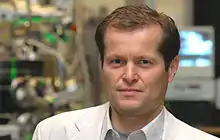Ferenc Krausz
Ferenc Krausz (born 17 May 1962 in Mór, Hungary) is a Hungarian-Austrian physicist, whose research team has generated and measured the first attosecond light pulse and used it for capturing electrons’ motion inside atoms, marking the birth of attophysics.[1]

Academic career
Krausz studied theoretical physics at Eötvös Loránd University and electrical engineering at the Technical University of Budapest in Hungary. After his habilitation at the Technical University of Vienna, in Austria, he became professor at the same institute. In 2003 he was appointed director at the Max Planck Institute for Quantum Optics in Garching and in 2004 became chair of experimental physics at the Ludwig Maximilians University in Munich. In 2006 he co-founded the Munich-Centre of Advanced Photonics (MAP) and began serving as one of its directors.[2]
Research
Ferenc Krausz and his research team were the first to create and measure a light pulse lasting less than one femtosecond. The researchers used these attosecond light pulses to make the inner-atomic movement of electrons observable in real time. These results marked the beginning of attosecond physics.[3][4][5][6]
In the 1990s, the groundwork for this landmark was done by Ferenc Krausz and his team with a large number of innovations[7] to the further development of the femtosecond laser technology to its ultimate limits – towards light pulses which carry the major part of their energy in one single oscillation of the electromagnetic field. An indispensable prerequisite for the generation of such short light pulses is the high-precision control of the delay of the different color components of broadband (white) light over one entire octave. Aperiodic multi-layers (chirped mirrors) emerging from a collaboration of Ferenc Krausz and Robert Szipöcs[8] made such a control possible and are indispensable in today's femtosecond laser systems.
In 2001, Ferenc Krausz and his group were able for the first time not only to generate but also to measure[9] attosecond light pulses (of extreme ultraviolet light) by means of intense laser pulses consisting of one to two wave cycles. With this, they were shortly thereafter also able to trace the movement of electrons on the subatomic scale in real time.[10] The control of the wave form of the femtosecond pulse[11] demonstrated by Ferenc Krausz and his team and the resulting reproducible attosecond pulses enabled the establishment of the attosecond measuring technique[12][13] as the technological basis for experimental attosecond physics today. Over the past few years, Ferenc Krausz and his coworkers succeeded with these tools to control electrons in molecules[14] and – for the first time – observe in real time a large number of fundamental electron processes such as tunneling,[15] charge transport,[16] coherent EUV emission,[17] delayed photoelectric effect,[18] valence electron movement[19][20] and the control of the optical and electrical properties of dielectrics.[21][22] These results have been achieved with international cooperations with groups of scientists such as Joachim Burgdörfer, Paul Corkum, Theodor Hänsch, Misha Ivanov, Ulrich Heinzmann, Stephen Leone, Robin Santra, Mark Stockman and Marc Vrakking.
In 2019 he was awarded the Vladilen Letokhov Medal.[23]
References
- F. Krausz, M. Ivanov, Reviews of Modern Physics 81, 163 (2009). Archived 2015-09-23 at the Wayback Machine (PDF; 14,2 MB)
- "Prof. Dr. Ferenc Krausz".
- Silberberg, Yaron (2001). "Physics at the attosecond frontier". Nature. 414 (6863): 494–495. doi:10.1038/35107171. PMID 11734831. S2CID 4414832.
- Lewenstein, M. (2002). "PHYSICS: Resolving Physical Processes on the Attosecond Time Scale". Science. 297 (5584): 1131–1132. doi:10.1126/science.1075873. PMID 12183615. S2CID 35226097.
- Dimauro, Louis F. (2002). "Atomic photography". Nature. 419 (6909): 789–790. doi:10.1038/419789a. PMID 12397335. S2CID 37154095.
- Bucksbaum, Philip H. (2003). "Ultrafast control" (PDF). Nature. 421 (6923): 593–594. doi:10.1038/421593a. hdl:2027.42/62570. PMID 12571581. S2CID 12268311.
- T. Brabec & F. Krausz, Rev. Mod. Phys. 72, 545 (2000).
- R. Szipöcs, K. Ferencz, Ch. Spielmann & F. Krausz, Opt. Lett. 19, 201 (1994).
- M. Hentschel et al., Nature 414, 509 (2001).
- M. Drescher et al., Nature 419, 803 (2002).
- A. Baltuska et al., Nature 421, 611 (2003).
- R. Kienberger et al., Nature 427, 817 (2004).
- E. Goulielmakis et al., Science 305, 1267 (2004).
- M. Kling et al., Science 312, 246 (2006).
- M. Uiberacker et al., Nature 446, 627 (2007).
- A. Cavalieri et al., Nature 449, 1029 (2007).
- E. Goulielmakis et al., Science 320, 1614 (2008).
- M. Schultze et al., Science 328, 1658 (2010).
- E. Goulielmakis et al., Nature 466, 739 (2010).
- A. Wirth et al., Science 334, 195 (2011).
- A. Schiffrin et al., Nature 493, 70 (2013).
- et al., Nature 493, 75 (2013).
- "The first 2019 Vladilen Letokhov Medal goes to Ferenc Krausz". European Physical Society.